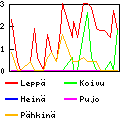Very big, very small
Traduction: [ Google | Babelfish ]
Catégories : [ Science ]
Scaling the solar system down to human sizes leads to more interesting comparisons. Let's assume the Earth is the size of a pin head (2 mm in diameter). We then have the following results:
- A human being living on the surface of the pinhead would be 0.30 nm (the size of two dihydrogen molecules)
- Mount Everest would be 1.4 μm tall (1/5 of the thickness of a strand of spider's web silk)
- Geostationary satellites would orbit the pin head at 5 mm from its surface but the International Space Station would be at only 60 μm from the surface (the thickness of a hair)
- A lightyear would be 1500 km long (the distance between Copenhagen, Denmark and Rome, Italy), so the closest star (Proxima Centauri) would be 6600 km away (distance between Paris, France and New Dehli, India, or between New York, USA and Berlin, Germany)
- The Oort cloud would be 3000 km in diameter (the distance between Madrid, Spain and Helsinki, Finland, with the volley ball representing the Sun located somewhere near Cologne, Germany)
- The diameter of the Milky Way (our galaxy) would be equivalent to the distance between the Sun and Earth
- The whole universe would be 20·1012 km in diameter, that is 2 lightyears (diameter of the Oort cloud, or half the distance to Proxima Centauri)
[ Posté le 15 mars 2012 à 10:06 | pas de commentaire | lien permanent ]






